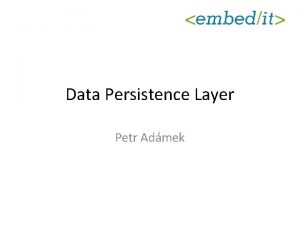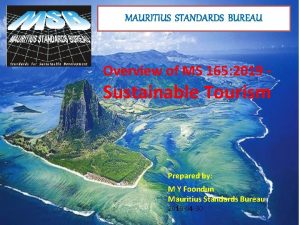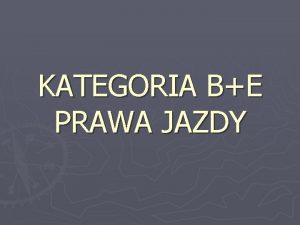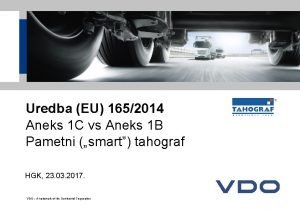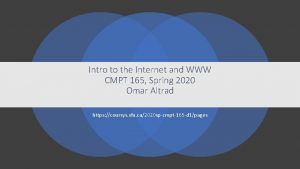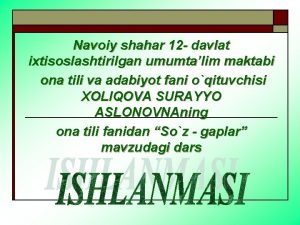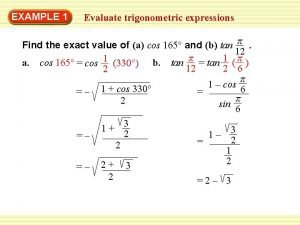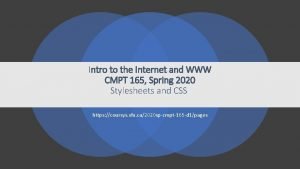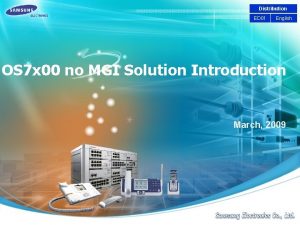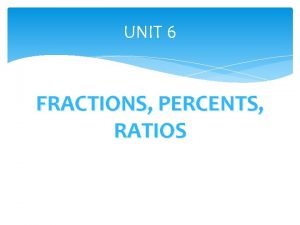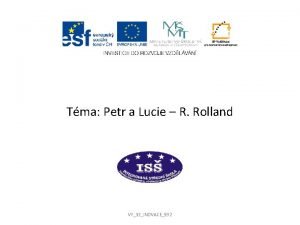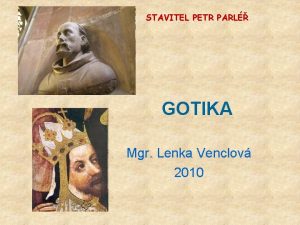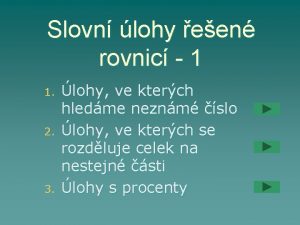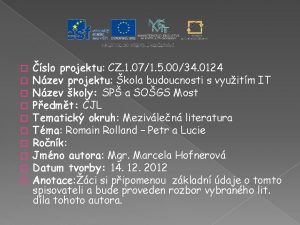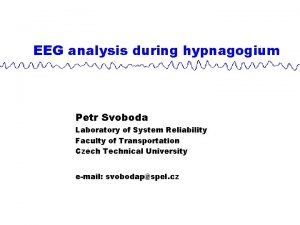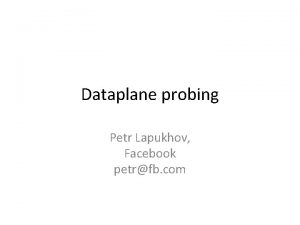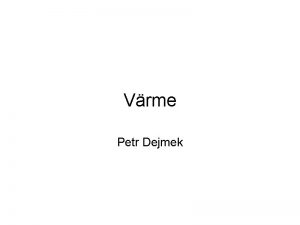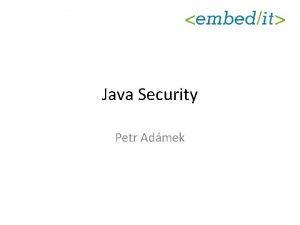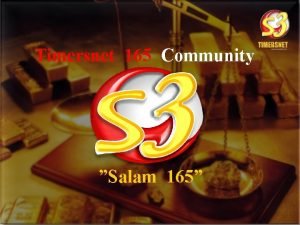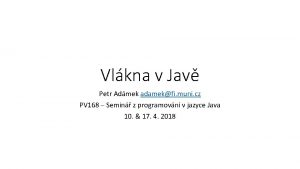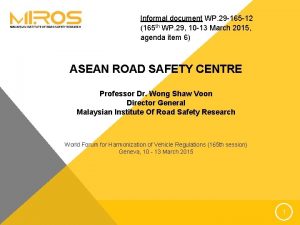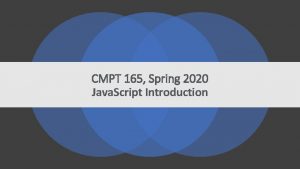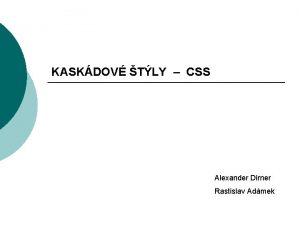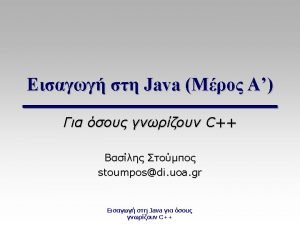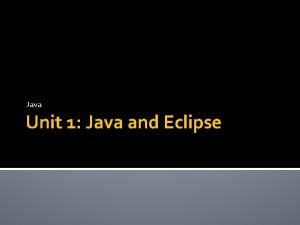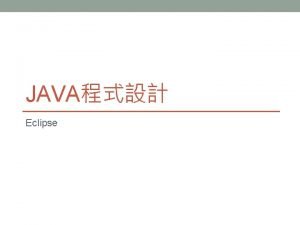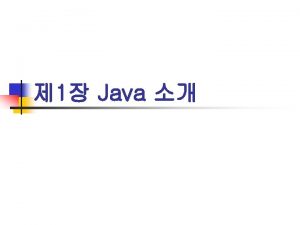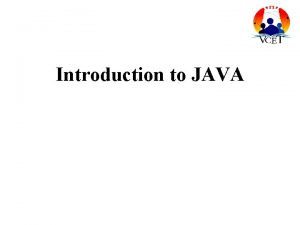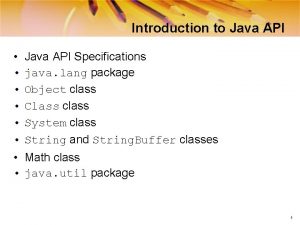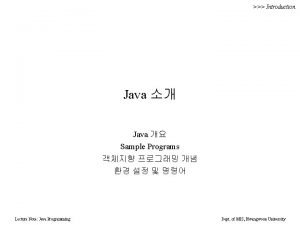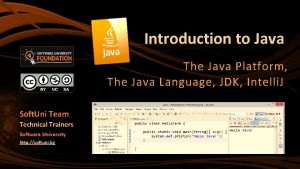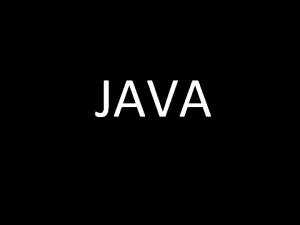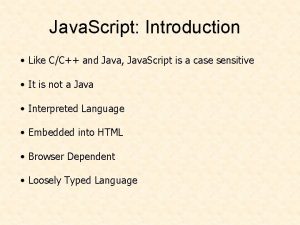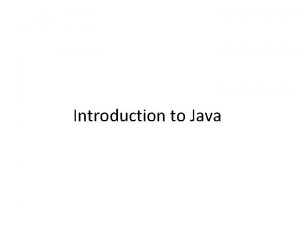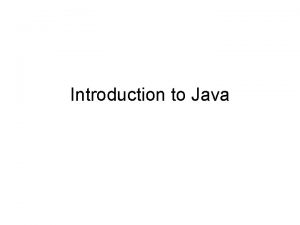PA 165 Introduction to Java EE Petr Admek




























- Slides: 28

PA 165: Introduction to Java EE Petr Adámek Tomáš Pitner Lecture 1, D 2, 12: 00 Tue Sep 16, 2014

Content • Course profile – Learning style – Assessment – Outline • • Java EE applications Java EE application architectures Technology around Java EE Basic concepts Fall 2014 - PA 165 – Lecture 1 2

ORGANIZATION OF THE COURSE Fall 2014 - PA 165 – Lecture 1 3

Course composition • Lectures – Recommended (slides in English, given in Czech) • Lab Sessions – Compulsory – Examples to the matter from lectures – Consulting the projects • Team Project – 4 -member teams – Checkpoints – Work throughout the semester Fall 2014 - PA 165 – Lecture 1 4

Assessment • Project: 70 points – Checkpoints: 4 x 10 points – Defense: 30 points • Final exam (written on paper): 30 points • Completion: – Credit: min. 60 points – Exam: min. 70 points Fall 2014 - PA 165 – Lecture 1 5

Course outline Intro to Java EE (architecture, technology, concepts) Data Persistence (ORM, JPA, Spring JDBC, i. Batis, Testing) Application logic (Io. C, AOP, Transactions, Security, Testing) Presentation layer (web frameworks, Stripes, Spring MVC, Wicket, JSF, Safety) • Integration technologies (Web services SOAP, REST, JMS, RMI, IIOP, ESB) • Testing (unit, integration, functional, acceptance, userfriendliness, efficiency, safety) • • Fall 2014 - PA 165 – Lecture 1 6

Recommended reading • Viz osnova předmětu Fall 2014 - PA 165 – Lecture 1 • Effective Java (2 nd Edition) • Joshua Bloch • http: //amazon. com/dp/ 0321356683/ • For more info see the course outline in IS 7

JAVA EE PLATFORM Fall 2014 - PA 165 – Lecture 1 8

What is Java EE Platform? • Platform for modern IS development – Provides the infrastructure – Industry standard (JCP) – Current version: Java EE 7 (since June 2013, still the current version) • Support for – Web applications – Web services – Multitier-applications Fall 2014 - PA 165 – Lecture 1 9

Modern Information Systems Complex and large systems Require integration with other systems Adaptability to different customer requirements Deployment on different platforms Support for a large number of clients (especially for Web applications) • Security • Quality and reliability • • • Fall 2014 - PA 165 – Lecture 1 10

IS Developer Needs Rapid development Easy maintenance Easy extensibility and customization Easy integration with other systems Support for agile Support for the team and multi-team development Portability Various software and hardware platforms, different tools and application servers • Scalability • Security • Easy to test • • Fall 2014 - PA 165 – Lecture 1 11

FUNDAMENTAL CONCEPTS Fall 2013 - PA 165 – Lecture 1 12

Fundamental concepts • • • Infrastructure Modularity Independence and low invasiveness Declarative access Convention over Configuration Adherence to the guidelines for the development of maintainable code Fall 2014 - PA 165 – Lecture 1 13

Infrastructure • The developer should focus on your problem domain and should not be forced to deal with general issues that must be addressed in any application. • Application architecture, security, transaction management, data persistence, communications and integration, remote access, infrastructure presentation layer, localization, etc. • Java EE platform and the built application framework (frameworks) therefore provide the necessary infrastructure. • Never implement your own framework! Fall 2014 - PA 165 – Lecture 1 14

Modularity • The application is developed as a set of cooperating components • Components should – Be loosely connected (loosely coupled), which between them should be as little dependent – Being reusable (whether only in the project, or even beyond) – Having a well designed and a separate interface (among other things, reduce the level of dependence, especially those in transition) – Being well-tested • If we have a set of well-designed components, it is easy to modify and adapt application behavior – Replacement of components – By changing the configuration of components – By changing the connections between components Fall 2014 - PA 165 – Lecture 1 15

Independent and less invasive • Components should be independent not only among themselves but also to specific technologies and application frameworks – At least at the level API • This simplifies maintenance and increases reusability • The concept of POJO (Plain Old Java Object) component – A common class that does not implement any specific interfaces or extend any particular class – It is therefore independent of any part or class library – Simple, clear understanding of the business does not require any special knowledge – You can easily create an instance, you can easily test Fall 2014 - PA 165 – Lecture 1 16

Declarative Approach • Certain aspects of program behavior are not defined by traditional imperative code (sequence of commands), but the specifications of the intent (what to do). • This leads to simplification and streamlining code. • Recommended for transaction management, security management and access rights, automated conversion, various automatic mapping, etc. • Self declaration desired behavior can be placed – In the deployment descriptor (deployment descriptor) – Directly in code via annotations (modern and preferred approach) Fall 2014 - PA 165 – Lecture 1 17

Imperative transaction control public void some. Method() { User. Transaction transaction = context. get. User. Transaction(); try { transaction. begin(); do. Something(); transaction. commit(); } catch (Exception ex){ try { transaction. rollback(); } catch (System. Exception syex){ throw new EJBException ("Rollback failed: " + syex. get. Message()); } throw new EJBException ("Transaction failed: " + ex. get. Message()); } } Fall 2014 - PA 165 – Lecture 1 18

Declarative transaction control @Transaction. Attribute(Transaction. Attribute. Type. Requires. New) public void some. Method() { do. Something(); } Fall 2014 - PA 165 – Lecture 1 19

Convention over Configuration • Concept … Ruby on Rails Fall 2014 - PA 165 – Lecture 1 20

In previous versions • The first version of the Java EE platform focused mainly on infrastructure and technology – – Ease of development was underestimated Complex technology is a complex application Steep learning curve The need to use complex tools • This led to the frustration developers and the emergence of alternative approaches and technologies (Hibernate, Spring) • The change came with Java EE 5 – Strong inspiration tool Spring, Hibernate, etc. – Annotations – POJO components Fall 2014 - PA 165 – Lecture 1 21

ARCHITECTURE & TECHNOLOGY Fall 2014 - PA 165 – Lecture 1 22

Mobile application Web Browser Webová vrstva (Web tier) Servlety JSP JSF Aplikační logika (Application logic) Aplikační vrstva (Business Tier) EJB ORM Integrační vrstva (EIS Tear) Databáze Fall 2014 - PA 165 – Lecture 1 Jiný IS 23 DB/IS server Perzistence dat (Data persistency) JDBC Spring Application server Prezentační vrstva (Presentation layer) Desktop application Client computer Klientská vrstva (Client Tier)

Presentation Layer Desktop applications – – Swing AWT SWT Java Web Start Mobile applications – Java ME – Android/i. OS/Black. Berry OS/Windows Phone Web applications – Servlets, JSP, JSTL – MVC frameworks • • Request based (Struts, Stripes, Spring MVC) Component based (JSF, Tapestery, Wicket) – Portlets – Applets Fall 2014 - PA 165 – Lecture 1 24

Application Logic Plain class library – Not suitable for larger applications EJB – Requires an application server supporting EJB or EJB lite Spring framework – 3 rd party (community) products, not part of Java EE – Very popular – Non-invasive Fall 2014 - PA 165 – Lecture 1 25

Data Persistence JDBC – Universal API for DB access – Cumbersome (too low-level) when used directly, so we use: • • Template Method Spring JDBC Commons DB Row. Set ORM – Standard JPA (currently JPA 2. 0) – Hibernate, Top. Link, Eclipse Link Obsolete – EJB 2. x – JDO Fall 2014 - PA 165 – Lecture 1 26

Application servers Open Source - full • JBoss • Glassfish Open Source - only servlet container • Tomcat • Jetty Commercial • Web. Sphere (IBM) • Web. Logic (Oracle, formerly BEA) Fall 2014 - PA 165 – Lecture 1 27

Questions ? Fall 2014 - PA 165 – Lecture 1 28
 Data persistence layer
Data persistence layer Ms 165
Ms 165 Scudo 165 multijet
Scudo 165 multijet Uredba 165/14
Uredba 165/14 Sfu cmpt 165
Sfu cmpt 165 Atov gapga misollar
Atov gapga misollar Evaluate the expression trigonometry
Evaluate the expression trigonometry 165 withholding statement excel file
165 withholding statement excel file écris tous les diviseurs de 24
écris tous les diviseurs de 24 Art 165 ley de transito
Art 165 ley de transito Cmpt 165
Cmpt 165 Uredba eu 165/14
Uredba eu 165/14 Nilai dari cos 165 derajat adalah
Nilai dari cos 165 derajat adalah 40000/165
40000/165 Cchs 165
Cchs 165 Mathsnacks.com ratio rumble
Mathsnacks.com ratio rumble Petr aubier
Petr aubier Stavitel petr
Stavitel petr Petr měl obdélník šířky 2 cm a neznámé délky
Petr měl obdélník šířky 2 cm a neznámé délky Petr a lucie rozbor
Petr a lucie rozbor Petr a lucie hlavní myšlenka
Petr a lucie hlavní myšlenka Petr skryja
Petr skryja Petr iljič čajkovskij prezentace
Petr iljič čajkovskij prezentace Petr dejmek
Petr dejmek Petr svoboda lab
Petr svoboda lab Petr lapukhov
Petr lapukhov Petr dejmek
Petr dejmek Vnve
Vnve Petr dokáže udělat celou práci sám za 6 hodin
Petr dokáže udělat celou práci sám za 6 hodin
